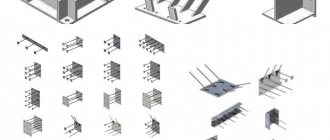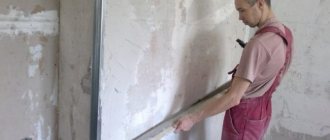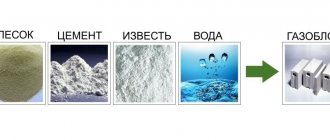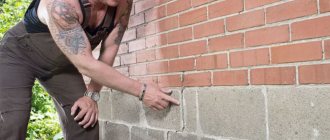Beton-House.com
Website about concrete: construction, characteristics, design. We combine the experience of professionals and private craftsmen in one place
Ready block
Self-production of any building material is not as simple a process as it seems at first glance. To implement your plans, you will need certain knowledge, and sometimes even skills.
We will try to clearly explain how to use sawdust concrete for the construction of walls and make sawdust concrete with our own hands - the video presented here for clarity will become an additional aid in this matter.
- Purchase of raw materials and selection of necessary equipment
Material composition
The main components that make up the material are: sand, cement, clay or lime and sawdust. In addition to these ingredients, certain chemical components are added that can affect the characteristics of the material.
Wood chips act as filler
Calcium chloride or nitrate, aluminum sulfate and liquid glass are added to increase the adhesion of the organic component in the form of sawdust and cement mortar.
Composition in %
The quality of the finished material, as well as the time it takes to reach brand strength, is influenced by the wood component. What sawdust is most suitable?
- It is recommended to use sawdust from coniferous trees, the size of which varies from 1 to 4 mm.
- Coniferous sawdust is less susceptible to biological decomposition than others.
- The best option would be spruce sawdust filler.
- As already mentioned, adhesion depends on the type of wood chosen. For example, a mixture containing spruce sawdust will harden in 10-12 hours, while a mixture containing larch sawdust will harden in only 4-5 days.
Sawdust must be pre-treated.
There are several ways:
- Soaking the future filler in water;
- Drying in the sun;
- Treatment with liquid glass or calcium chloride.
On a note! Do not add too much chemicals. The permissible norm is 1 part of the chemical component to 40 parts of sawdust.
Now let’s get acquainted with the ratio of the components and find out how to change the proportions in order to obtain products of different grades of strength.
Sawdust concrete: composition and proportions:
| Strength grade | Sawdust, kg | Cement grade 400, kg | Sand, kg | Slaked lime, kg |
| Grade M10 is suitable for one-story construction | 210 | 95 | 535 | 160 |
| Using the M15 brand, you can build a two-story building | 195 | 140 | 615 | 100 |
| M25 – the most durable, used in the construction of load-bearing structures | 185 | 305 | 675 | 95 |
Note! The recipe is approximate and is a recommendation. There are no exact proportions for different manufacturers; therefore, products may differ significantly in characteristics. That is why, when making it yourself, part of the raw materials is often spent on experiments with the composition.
When examining the table, the conclusion suggests itself: the proportions of raw materials directly affect the result, or, more precisely, the properties of the products. The higher the percentage of cement, the higher the strength grade. As a result, the ability to retain heat decreases, but the characteristics of frost resistance and durability, as a rule, increase.
Varieties
Structural sawdust concrete blocks are used for the construction of walls and arrangement of interior partitions.
Depending on their purpose, sawdust blocks come in the following varieties:
- thermal insulation;
- structural.
Based on density, the material is divided into classes M5, 10, 15, 20. The densest block is M5. It is used as the main material for the construction of sawdust concrete houses. Repair of wall surfaces is carried out using M10 class products, but for cladding and arrangement of interior partitions, M15 and 20 blocks are more suitable.
Why should you give preference to sawdust concrete?
Do you know how sawdust block stands out from other materials, and what are its main advantages? Let's figure out whether it is worth making or purchasing these products to build your own home.
Basic set of benefits
Let's start with the strengths:
- The thermal efficiency of the sawdust block is really high. We can say that the material is one of the leaders in this regard. When compared with representatives of lightweight concrete, these products are surpassed only by polystyrene concrete, the coefficient of which is from 0.05 W*mS. Sawdust concrete, in turn, can boast an indicator from 0.07 to 0.20.
- Average density grades can be different; they are also related to strength characteristics. The specific gravity can range from 400 to 850 kg/m3. Sawdust concrete can be used not only for heat and sound insulation, but also in the construction of houses.
- Frost resistance of the material should also be considered a positive quality. The number of cycles that the unit can withstand is from 25 to 50.
- We have already considered the composition of the material. The content of the components indicates the complete environmental friendliness of sawdust concrete.
- It may be surprising at first glance, but it does not burn, despite the sawdust content. Why? It's simple: cement mortar prevents combustion.
- The products can be safely called “breathable”. Vapor permeability is approximately 35%.
- Soundproofing ability is also present.
- Sawdust concrete can be made with your own hands, and this is a great opportunity to try your hand at being a manufacturer, or save a little on the construction of a building.
- The market price for the products is low.
- The block is easy to process, and its dimensions are relatively large. These facts indicate an increased speed of construction of structures and ease of use.
Thermal conductivity compared to other materials
Disadvantages of products
This block really has many advantages, but there are also disadvantages, so we will pay attention to them:
- It is quite hygroscopic. It absorbs moisture intensively. Although it is worth paying tribute and saying that this figure is far from the largest among wall products.
- The material is subject to shrinkage.
- Since the production technology is not entirely complex, it is often produced in artisanal conditions. The quality of such products is not controlled or tested, which increases the risk of purchasing products that do not meet the standards.
- Sawdust concrete takes a long time to reach brand strength, up to several months.
- The geometry of products often leaves much to be desired.
Laying a block with poor geometry
Introduction
One of the representatives of the “family” of cellular concrete is sawdust concrete. Developed and passed all tests back in Soviet times, due to its low cost it became popular at the height of the last decade of the last century.
The main advantages of using sawdust concrete:
- No harm to the environment, unlike polystyrene concrete;
- Complete fire safety;
- Steam conductivity (Buildings can “breathe”);
- Thermal performance indicators;
- Resistant even against severe frosts;
- Economic profitability of use.
Manufacturing process
Since our brief introduction to the material is complete, let’s figure out how sawdust concrete is made at home.
Purchase of raw materials and selection of necessary equipment
Before starting the production process, you will have to purchase the necessary raw materials and equipment.
Here are some tips to follow when purchasing components for preparing the solution:
- The cement must be of a high grade: M400 or M500. The higher this value, the greater your chances of getting the most durable products.
- You should not purchase expired materials, especially the above-mentioned cement.
- If you want to save money, you can try to find someone willing to give you sawdust for free, because after all, it is a waste product from wood production. Therefore, it is quite possible to try to contact the owners of sawmills.
- It is worth purchasing chemical components for preparing sawdust - this way you can improve the quality of the finished material and reduce its setting time.
- If you need to purchase a relatively large amount of raw materials, you should pay attention to wholesale suppliers and buy everything at once in one place. This way you will have a better chance of getting a good discount, and thereby reducing the cost of the material.
The production of sawdust concrete at home requires a minimum set of equipment, which is a set of molds and a concrete mixer. You can also purchase a vibropress, which helps to better compact the concrete during molding.
Using this unit, the ability to produce more durable products increases.
You can also make your own molds. Often sheets of plywood are used for this. It is best to build 10-20 molds at once so that the production process does not stop, because the products must dry for about 3-4 days before stripping.
Making your own mold, photo
The video in this article will show how you can build molds for a sawdust concrete block yourself.
Technological stages
The technology for manufacturing sawdust concrete is not too complicated and consists of several stages.
The instructions look like this:
- First of all, you need to mix the solution.
- The sawdust is first prepared and sifted through a sieve.
- In fact, components can be loaded in any order. The most common option is the following: mix cement and water, then add sand, lime and sawdust.
- All ingredients are mixed until a homogeneous mass is formed for the required period of time.
- The readiness of the solution can be easily checked in a fairly primitive way: squeeze a little of the prepared mixture in your fist, no water should be released. And when you unclench your fist, the mixture should not lose its shape.
- The next stage will be the molding of the products.
- The forms are filled and the mixture is compacted.
- If there is a vibropress, molding occurs using it.
- Next, the blocks should dry.
- You can also check their readiness: run a nail along the surface of the product and pay attention to the mark. If it is shallow, then the blocks are ready for removal and further drying.
- At the end of the manufacturing process, the sawdust concrete block is sent for drying until it reaches brand strength.
Advice! To facilitate the process of stripping the products, pieces of linoleum or similar material can be nailed to the inside of the forms. In this case, the blocks will easily move away from the walls.
Particular attention should be paid to monolithic sawdust concrete, because the material is used not only in the form of blocks, but also in liquid form when pouring various structures.
In order to fill, you must:
- Mixer for mixing;
- The raw materials included in the composition must be within walking distance;
- Construction containers in the form of a tub;
- Tamping beam with a pointed end.
Using monolithic material, you can fill up to 2 cubes of the mixture per day. The main advantage of monolithic construction is the absence of the process of producing blocks and, accordingly, masonry work.
Among the disadvantages, it is worth highlighting the extremely long development of strength, which does not allow you to quickly remove the formwork and continue construction.
Application of monolithic sawdust concrete
If you decide to make sawdust concrete with your own hands, the video will help you with the work.
How to do it yourself?
Blend recipe
The proportions of sawdust concrete determine the density and strength coefficient of the finished material. To prepare high-density concrete, you will need components in the following quantities:
- wood chips - 1 t;
- cement - 1 t;
- sand - 2.5 tons;
- lime 250 kg.
In addition to observing the specified proportions, it is important to adhere to the order of mixing the components. First you need to combine the required amount of sand with cement and mix thoroughly. Then sawdust and lime are added and mixed again. At the end, water is added little by little until the required consistency is obtained. To make the concrete dough homogeneous, it is recommended to prepare it in a concrete mixer.
A properly prepared solution is elastic, after compression it remains in the same shape, does not crumble or deform.
Formwork and forms
Identical dimensions are achieved by using a mold or formwork, into which the finished mixture is compacted.
To ensure that the blocks come out the same size, it is recommended to purchase or make your own molds for pouring. The formwork is made of wooden boards; it is recommended to make collapsible forms so that they can be quickly assembled and then disassembled. The mixture is placed in molds and compacted thoroughly. The solution sets in 3-4 hours, but the product must sit for 5-7 days. Drying of sawdust blocks is carried out in a well-ventilated area. Then the blocks are laid out in low pillars, where the greatest density is achieved.
Briefly about the features of using the material in construction
- The products can be laid using glue or cement-sand mortar.
- If the geometry of the block is good, then, of course, it is better to give preference to the adhesive composition. Otherwise, you should use a solution.
- Of course, the use of the latter is not entirely desirable, since the heat-saving capabilities of the wall will be reduced.
To carry out the work you need to purchase some tools:
- Saw or hacksaw for cutting products;
- Level;
- Square;
- Drill mixer;
- Construction bucket for mixing, in case of using glue;
- Tool for applying the solution;
- Thread or cord;
- Mallet;
- Metal mesh for the reinforcement procedure.
Let's consider the order of work.
Construction of a sawdust concrete wall:
| Guide blocks are placed in the corners, and a cord is pulled between them. Both blocks and thread will serve as a good guide in the process of laying products.
The next step will be laying the entire first row using a self-prepared solution. |
| The second and all subsequent rows are laid in compliance with the dressing. |
| If necessary, the block is cut to the required size. |
| Reinforcement is recommended to be done every third or fourth row. |
| You can check the evenness of the products using a level. If necessary, correction should be made using a mallet. |
| By analogy, the entire wall is laid out to the desired height. |
Our wall is ready! Now you will be able not only to produce the blocks yourself, but also to lay them.
My new book
Quite recently, my new book “Business on sawdust and woodworking waste” was published. The book will help a novice businessman figure out which direction he should move in order to achieve the best results in the shortest possible time.
The book provides specific calculations that clearly indicate that with such and such parameters, you are better off starting this business, and with other initial data, it is better to start another business. More information about receiving a book can be found in the “BOOKS” section in the top menu.
Wood concrete and sawdust concrete: is there a difference?
Many people wonder what is better to use: wood concrete or sawdust concrete? It will not be difficult to answer this question, since there is practically no difference between these materials.
Sawdust concrete and wood concrete
- The difference lies only in the form of the wood filler: for sawdust concrete it is sawdust, for wood concrete it is wood chips.
- Yes, indeed, some properties of the above products differ, this concerns the ratio of strength and thermal conductivity, fragility and some other performance characteristics. But, in essence, it is the same thing.
- Another difference is the price of the products. Wood chips cost the manufacturer much more than sawdust, and they are more difficult to process. As a rule, the cost of products varies by 10-15%.
If you want to make wood concrete at home, it is worth noting that the technologies are similar. You just need to change the shape of the wood filler and explore the variability of its preparation.











